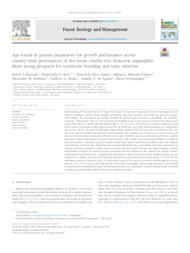Age trends in genetic parameters for growth performance across country-wide provenances of the iconic conifer tree Araucaria angustifolia show strong prospects for systematic breeding and early selection.
Age trends in genetic parameters for growth performance across country-wide provenances of the iconic conifer tree Araucaria angustifolia show strong prospects for systematic breeding and early selection.
Author(s): RESENDE, R. T.; SILVA, P. I. T.; SILVA JUNIOR, O. B. da; FREITAS, M. L. M.; SEBBENN, A. M.; SOUSA, V. A. de; AGUIAR, A. V. de; GRATTAPAGLIA, D.
Summary: Understanding the growth patterns of long-lived conifer tree species is important to devise breeding and early selection strategies, predict future biomass productivity and assess adaptive tree fitness for long term conservation efforts. We investigated the genetic variation for growth traits of Araucaria angustifolia, the grandiose renowned ?Parana ´ pine? tree, in a trial involving 122 families across 15 provenances covering the entire natural range of the species in Brazil. Measurements at ages 7, 24, 32, 33 and 35 were used to adjust continuous growth curves based on nonlinear mixed-effect models for all 2158 trees, providing annual estimates for unmeasured ages in the 7-to-35-year interval. Estimated values closely matched observed ones and a reduction of the coefficient of residual variation was observed in the estimated data, possibly due to removal of random error in the observed measurements, making the estimated curves more reliable to predict growth patterns. Genetic variation for growth within provenances was greater than between, with a trend of increasing heritabilities over time for most provenances. Substantial genetic variation found both within and between families could drive efficient early selection at both levels. All provenances included individual trees and families with good potential to be selected for shorter rotations. Growth curves show that trees invest first in height and later in diameter growth. Considerable variation was observed across provenances for the optimal age and optimal tree volume at which annual growth increment peaks, a tipping point that could be used as a predictor of the optimal rotation age and expected tree volume. The data clearly indicate potential for early selection for growth at age 7?10 with an 85% prediction accuracy of growth at age 35. Additionally, growth data indicate potential of shortening harvest age from 30?35 to 15?20 years by selecting the best individuals and families. These results underscore the potential of expanding investments in breeding and plantation forestry of A. angustifolia, which in parallel could contribute to enhancing conservation efforts of this iconic subtropical conifer.
Publication year: 2021
Types of publication: Journal article
Observation
Some of Embrapa's publications are published as ePub files. To read them, use or download one of the following free software options to your computer or mobile device. Android: Google Play Books; IOS: iBooks; Windows and Linux: Calibre.
Access other publications
Access the Agricultural Research Database (BDPA) to consult Embrapa's full library collection and records.
Visit Embrapa Bookstore to purchase books and other publications sold by Embrapa.

